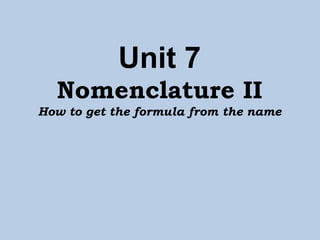
Naming 2 SMART
- 1. Unit 7 Nomenclature II How to get the formula from the name
- 2. Binary Covalent Compounds Binary covalent compounds are compounds with two (2) nonmetals (Ex. CO, SF6, P2O5).
- 3. Binary Covalent Compounds Determining the formula: Identify the elements in the compound. Confirm they are both nonmetals. Use the prefix to tell how many atoms of each element there are in the compound. mono = 1 •di = 2 • tri = 3 • tetra = 4 •penta = 5 hexa = 6 •hepta = 7 •octo = 8 •nona = 9 •deca = 10
- 4. Binary Covalent Compounds Determining the formula: To indicate how many atoms of each element are in the formula, use subscripts. Example: carbon dioxide has 1 carbon and 2 oxygens = C1O2 = CO2 (carbon’s 1 subscript is understood) mono = 1 •di = 2 • tri = 3 • tetra = 4 •penta = 5 hexa = 6 •hepta = 7 •octo = 8 •nona = 9 •deca = 10
- 5. Binary Covalent Compounds Practice: selenium tetrafluoride __________________________________ octaphosphoruspentabromide __________________________________ heptanitrogenhexachloride __________________________________ iodine trifluoride __________________________________ mono = 1 •di = 2 • tri = 3 • tetra = 4 •penta = 5 hexa = 6 •hepta = 7 •octo = 8 •nona = 9 •deca = 10
- 6. Acids Acid - a compound that produces hydrogen ions, (H+) when dissolved in water. An acid will always end in the word "acid"! Also, an acid formula will always begin with hydrogen!
- 7. Acids Finding the formula of an acid 1) What kind of acid is it? If it begins with “hydro”, it is binary, meaning hydrogen bound to a nonmetal. If it does not begin with “hydro”, it is ternary, meaning hydrogen bound to a polyatomic ion.
- 8. Acids Finding the formula of an acid 2) Find the formula of a binary acid! a. First, identify the nonmetal from the root of the word before acid. Example: Hydrochloric Acid the nonmetal is chlorine.
- 9. Acids Finding the formula of an acid Find the formula of a binary acid! b. Then, find the oxidation number of hydrogen (always 1+) and the nonmetal and write them as superscripts of each ion. This makes a cation(+) and an anion(–) Example: H+1 Cl–1
- 10. Acids Finding the formula of an acid 2) Find the formula of a binary acid! c. Next, CRISS-CROSS the number of each oxidation number (NOT the charge!) down to the subscript of the opposite ion to indicate how many atoms you have of each ion in the compound. Example: H+1Cl–1 = H1 Cl1
- 11. Acids Finding the formula of an acid 2) Find the formula of a binary acid! d. Reduce subscripts to lowest whole number ratio. ExampleHCl (1 subscripts are understood)
- 12. Acids Finding the formula of an acid 2) Find the formula of a binary acid! Practice: Hydrochloric Acid_________________________________ Hydroselenic Acid_________________________________ Hydroiodic Acid _________________________________
- 13. Acids Finding the formula of an acid 3) Find the formula of a Ternary Acid! a. Identify the polyatomic ion. i. If it ends in “-ous” acid, change the end to “-ite”, look up on polyatomic ion list. ii. If it ends in “-ic” acid, change the end to “-ate”, look up on polyatomic ion list.
- 14. Acids Finding the formula of an acid 3) Find the formula of a Ternary Acid! Write the oxidation numbers of H and the polyatomic anion as superscripts Criss cross the numbers only (not the charge!) Reduce subscripts to lowest whole number ratio. SAME AS BINARY ACIDS
- 15. Acids Finding the formula of an acid 3) Find the formula of a Ternary Acid! Practice: Chlorous Acid____________________________________ Sulfuric Acid____________________________________ Perchloric Acid____________________________________
- 16. Ionic Compounds Ionic Compoundsare made of a metal and a nonmetal (KCl, NaCl, NaI, CaCl2, BeF2).
- 17. Ionic Compounds Determining the Formula of an Ionic Compound 1) Identify the elements that make up the compound a. The first term, the metal, is the cation (+) and will look the same as it does on the periodic table. b. The second term, the nonmetal, is the anion (–) and its ending has been changed to"-ide”. Determine the element name from the root of the word.
- 18. Ionic Compounds Determining the Formula of an Ionic Compound 2) Form the cation and anion by looking at oxidation numbers. 3) Use the criss-cross method to form the compound. 4) Reduce subscripts to lowest whole numbers.
- 19. Ionic Compounds Practice: sodium chloride ____________________________________________ magnesium fluoride ____________________________________________ aluminum iodide ____________________________________________ calcium sulfide ____________________________________________
- 20. Compounds with Polyatomic Ions Polyatomic ions are groups of covalently bonded atoms that function as ions.
- 21. Compounds w/Polyatomic Ions Determining the Formula: 1) Identify the first term, the cation (+), and the second term, the anion (–) a. the cation, anion, or BOTH may be polyatomic ions. 2) Form the cation and anion by looking at oxidation numbers. 3) Use the criss-cross method to form the compound. 4) Reduce subscripts to lowest whole numbers.
- 22. Compounds w/Polyatomic Ions Practice: Sodium cyanide ________________________________ Aluminum nitrite ________________________________ Ammonium silicate ________________________________
- 23. Ionic Compounds w/ Transition Metals Transition metals are the d block on the periodic table!
- 24. Ionic Compounds w/ Transition Metals Determining the Formula from the Name: 1) Identify the transition metal and the anion. 2) Form the cation and anion by finding the oxidation numbers of the ions. a. transition metal - the Roman numeral b. anion - periodic table groups or polyatomic ions 3) Use the criss-cross method to form the compound. 4) Reduce subscripts to lowest whole numbers.
- 25. Ionic Compounds w/ Transition Metals Practice: tin (IV) iodide__________________ mercury (II) sulfide______________ iron (III) oxide__________________ nickel (III) sulfate________________ chromium (VI) phosphate__________